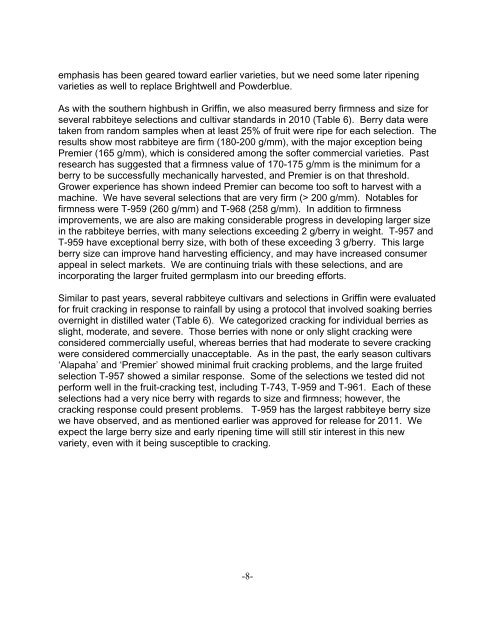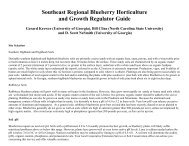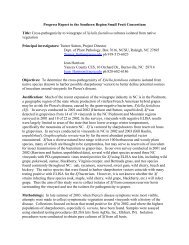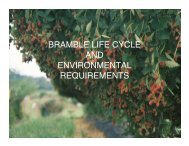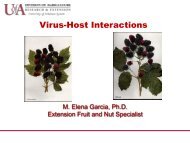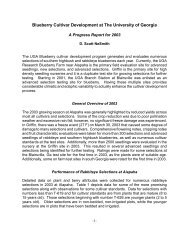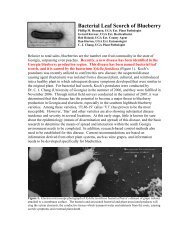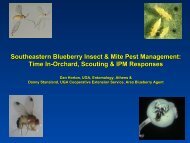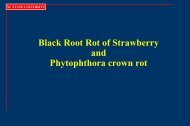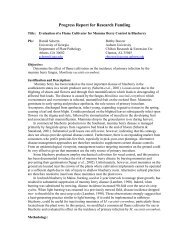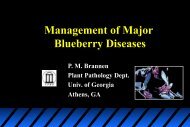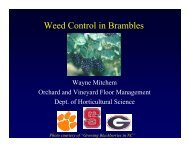Blueberry Cultivar Development at The University of Georgia
Blueberry Cultivar Development at The University of Georgia
Blueberry Cultivar Development at The University of Georgia
Create successful ePaper yourself
Turn your PDF publications into a flip-book with our unique Google optimized e-Paper software.
emphasis has been geared toward earlier varieties, but we need some l<strong>at</strong>er ripeningvarieties as well to replace Brightwell and Powderblue.As with the southern highbush in Griffin, we also measured berry firmness and size forseveral rabbiteye selections and cultivar standards in 2010 (Table 6). Berry d<strong>at</strong>a weretaken from random samples when <strong>at</strong> least 25% <strong>of</strong> fruit were ripe for each selection. <strong>The</strong>results show most rabbiteye are firm (180-200 g/mm), with the major exception beingPremier (165 g/mm), which is considered among the s<strong>of</strong>ter commercial varieties. Pastresearch has suggested th<strong>at</strong> a firmness value <strong>of</strong> 170-175 g/mm is the minimum for aberry to be successfully mechanically harvested, and Premier is on th<strong>at</strong> threshold.Grower experience has shown indeed Premier can become too s<strong>of</strong>t to harvest with amachine. We have several selections th<strong>at</strong> are very firm (> 200 g/mm). Notables forfirmness were T-959 (260 g/mm) and T-968 (258 g/mm). In addition to firmnessimprovements, we are also are making considerable progress in developing larger sizein the rabbiteye berries, with many selections exceeding 2 g/berry in weight. T-957 andT-959 have exceptional berry size, with both <strong>of</strong> these exceeding 3 g/berry. This largeberry size can improve hand harvesting efficiency, and may have increased consumerappeal in select markets. We are continuing trials with these selections, and areincorpor<strong>at</strong>ing the larger fruited germplasm into our breeding efforts.Similar to past years, several rabbiteye cultivars and selections in Griffin were evalu<strong>at</strong>edfor fruit cracking in response to rainfall by using a protocol th<strong>at</strong> involved soaking berriesovernight in distilled w<strong>at</strong>er (Table 6). We c<strong>at</strong>egorized cracking for individual berries asslight, moder<strong>at</strong>e, and severe. Those berries with none or only slight cracking wereconsidered commercially useful, whereas berries th<strong>at</strong> had moder<strong>at</strong>e to severe crackingwere considered commercially unacceptable. As in the past, the early season cultivars‘Alapaha’ and ‘Premier’ showed minimal fruit cracking problems, and the large fruitedselection T-957 showed a similar response. Some <strong>of</strong> the selections we tested did notperform well in the fruit-cracking test, including T-743, T-959 and T-961. Each <strong>of</strong> theseselections had a very nice berry with regards to size and firmness; however, thecracking response could present problems. T-959 has the largest rabbiteye berry sizewe have observed, and as mentioned earlier was approved for release for 2011. Weexpect the large berry size and early ripening time will still stir interest in this newvariety, even with it being susceptible to cracking.-8-


